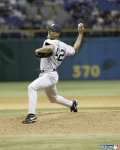Bold above ... my personal throw is more like how Hodge describes the throw ... or a subset of Hodge's description ... Hodge misses the importance of thoracic extension, and that is present in my throw.
Watched a local Varsity HS game this morning. The majority of throws were more like Tewks described where the front thigh was more of a trigger for re-direction ... those using the front thigh as a trigger for external rotation were in the minority. Also as an FYI, 100% of those making decent throws performed thoracic extension on the onset of the lead thigh trigger.
I am a true believer now....
...believe in the critical importance of thoracic extension, as you call it (I'm not that technical). Worked on this with my 10 year old for whom throwing mechanics are her weakest link. I've never had such incredible results in a shorter time. She threw some lasers
...believe the importance of TE is missing from Hodge
...believe Tewks is indeed onto the importance of TE...however, I do not necessarily believe in (or against) bending the arm way behind the head. It is the getting the weight "back-back" part, as Tewks puts it, that is critical.
Also, curious about the sequence. So, when you say "like Tewks described", are we saying Tewks promotes a specific mechanics that are different, or is it just that this girl happens to be at a certain point? Do you believe in one or the other? Sounds like you still favor timing as Hodge describes it, if I understand you correctly.





